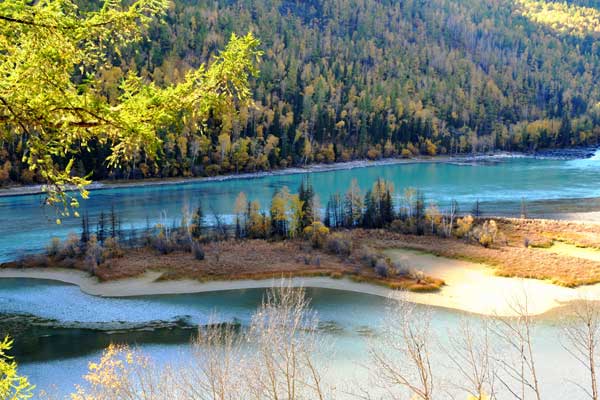Off the beaten track, take a break this fall to explore three hidden gems that the vast expanse of China has to offer, writes Zhang Zixuan.
Summer along with its scorching heat and breathless days has given way to fall, which is probably the best season for traveling in China. This is also perhaps the best time to visit Kanas Lake to have a chance meeting with the mysterious "water monster", navigate the less than 1-meter-wide alleys in Xitang, or watch the sun dip below the horizon from a boat rolling gently on Baiyangdian lake. Traveling is not only about giving a break to our body and mind from the dreariness of everyday life, but also about rejuvenating the soul.
1. Kanas, Xinjiang Uygur autonomous region

The picture perfect Kanas Lake, surrounded by virgin forests and pristine grasslands, is the biggest draw in Kanas.[photos provided to China Daily]
Situated in Burqin county of Altai city in Xinjiang, Kanas is called the "Switzerland of the Orient" and the "heaven for photographers".
In "Kanas", which means beautiful, rich and mysterious in the Mongolian language, you'll see the tranquil Kanas Lake change color as the day progresses and the seasons change thanks to the spectacular glaciers that embrace it from all sides.
Kanas is home to virgin forests surrounded by pristine grasslands. It is also home to the Tuva people — closely related to Mongolians — and many rare species of mammals and birds.
Kanas shares the border with Kazakhstan, Russia and Mongolia, and its 44.78-square-kilometer lake is shaped like a bean pod.
The Kanas Lake, situated at an altitude of over 1,340 meters above the sea level, is famous for its natural beauty and discreet charm. But it is also known for the mysterious water monster, which many believe has killed horses drinking water from the lake or resting near its banks. Rumor has it that the monster drags horses deep into the water.
There are several versions of what the monster looks like. Some say it is the last of the dinosaurs, while a few claim its head resembles that of a giant dog. Others ascribe the water monster myth to huge red fish called hucho taimen, which have big sharp teeth.
Many tourists have captured the water monster, albeit just part of it, on their still and video cameras. But none of the images is clear and convincing enough to prove the existence of the monster.
Myth or reality, the creature does not deter tourists from enjoying the heavenly beauty of the lake. In fact, the opposite is true. Tourists in droves visit the lake, with more brave hearts seeking to unravel the truth.
The Wolong Bay (or Crouching Dragon Bay) is another big attraction in the Kanas Lake area. The bay, on the Kanas River with its serpentine shoreline, resembles a Chinese dragon, hence the name.
Just one kilometer north of the Wolong Bay along the Kanas River is Moon Bay, which gets its name from its moon-like shape. It is like a pearl enhancing the mysterious beauty of the Kanas River. The Moon Bay's umbilical tie with the river prompts it to change its color along with that of the river.
There are two small shoals on the right bank of the Moon Bay, which look like a pair of footprints. Since the bay is named after the moon, local people believe the two footprints belong to the fairy maiden Chang'e, who is said to live on the moon.
While in Kanas do not forget to visit the neighboring Hemu, Baihaba and Kanas villages, where the Tuva people have preserved their lifestyle and traditions, including their houses which are built of wood, adding the Swiss ambiance to the place.
2. Xitang, Zhejiang province
Tom Cruise stayed in Xitang for a whole week in 2005 to shoot for Mission Impossible 3. Movie director J.J. Abrams chose Xitang as the setting for his film because he believed it represented real China.
The 1,000-year-old town has not changed much since the Hollywood star spent a week there eight years ago.
Xitang is part of Jiashan county in Zhejiang. It is divided into eight areas by nine river channels, which are connected by 27 bridges and hundreds of boats.
We Recommend:
